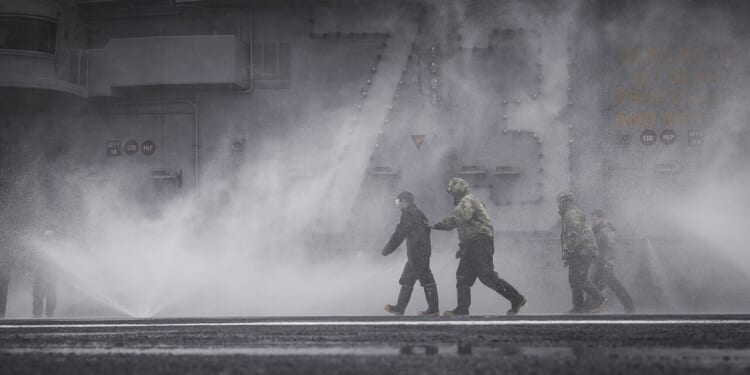The US Navy has spent decades perfecting the art of keeping planes aloft in a hostile and corrosive environment—mostly through extremely rigorous maintenance.
Operating aircraft at sea presents significant engineering and logistical challenges. The environment is a nightmare for man-made machines. Saltwater, humidity, and constant exposure to ultraviolet radiation can wreak havoc on steel hulls—devouring ships over decades. But aircraft, which are far smaller, thinner, and technically more sophisticated, are especially vulnerable. Wiring can rot. Fasteners can corrode. Bearings can seize. And the precision tolerances required to keep an aircraft airworthy can quickly erode.
Of course, the US Navy takes special steps—employing decades of innovation in materials science, design philosophy, and maintenance procedure to improve aircraft survivability in the world’s most corrosive operating environment. This is one reason that operating an air wing is so expensive, and so few nations have effectively pulled it off.
Navy Planes Are Specially Designed to Stand Up to the Elements
Corrosion prevention is critical to naval aircraft. Most of the airframe is built from alclad aluminum—a composite in which the structural alloy is encased in a thin layer of pure aluminum that oxidizes first, forming a sacrificial barrier. In places where strength and corrosion resistance are both vital, like the wing folds, landing gear struts, and catapult fittings, the designers use corrosion-resistant titanium or stainless steel, both of which are heavier and more expensive. Then, fasteners and control linkages are plated with cadmium or zinc-nickel, or replaced with titanium bolts, to replace galvanic corrosion where dissimilar metals meet.
Even before the ignore panel is painted, it is treated with a conversion coating like Aldine or Iridite to chemically stabilize the surface. Next, layers of epoxy primer and polyurethane topcoat are applied for anti-corrosion and UV-blocking. The paints applied to the aircraft are also tougher and more flexible than the pants one would find on a normal Air Force aircraft—designed to withstand the repeated exposure to salt spray, hydraulic fluid, and heat of jet exhaust that characterize life aboard an aircraft carrier.
The interior of the airframe is adapted, too. Inside the skin of the aircraft, every rivet and joint is sealed with polysulfide sealant to keep moisture from wicking into the substructure. Cavities and closed bays are vented and drained, so that any intruding seawater has a way out.
Naval Aviators Fight a Never-Ending Battle Against Corrosion
Internally, the Navy employs environmental hardening to sensitive systems, which would be unnecessary on land-based aircraft. Avionics are conformally coated, and their circuit boards are encased in thin epoxy or silicone layers that resist salt and humidity. Hydraulic actuators, hinges, and landing gear components are fitted with elastomeric boots or composite covers to keep spray out. Electrical connectors are weather-sealed and often feature redundant grounding paths to prevent corrosion-induced shorts.
The engine is modified, too. Anti-corrosion coatings are used to line compressor blades and inlet ducts while engine wash systems allow maintenance crews to rinse salt crystals out of the intake with freshwater between sorties.
Despite the comprehensive design efforts made to protect the aircraft, simple engineering is not enough. Navy aircraft are subjected to an exhaustive maintenance routine, baked into every sortie cycle to ensure enhanced survival. After each flight, the aircraft are washed down with freshwater to remove salt residue. The aircraft is inspected daily for corrosion effects, and applied with light oils and waxes that prevent corrosion. Control cables and hinges are re-lubricated constantly. And when corrosion is inevitably found, it is removed immediately with abrasion or chemical neutralization, and the area is resealed and repainted.
The results are fairly remarkable. Between the engineering modifications and the operational procedures, the Navy has made it possible to operate high-performance aircraft, like the F/A-18 Hornet, F-35C Lightning II, E-2D Hawkeye, and P-8A Poseidon, on the open seas for decades at a time.
About the Author: Harrison Kass
Harrison Kass is a senior defense and national security writer at The National Interest. Kass is an attorney and former political candidate who joined the US Air Force as a pilot trainee before being medically discharged. He focuses on military strategy, aerospace, and global security affairs. He holds a JD from the University of Oregon and a master’s in Global Journalism and International Relations from NYU.
Image: Wikimedia Commons.


















